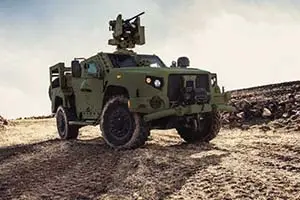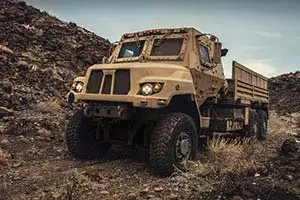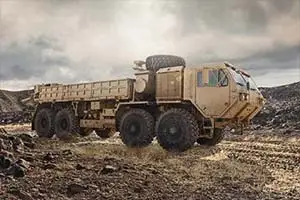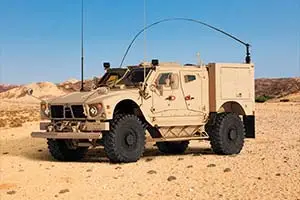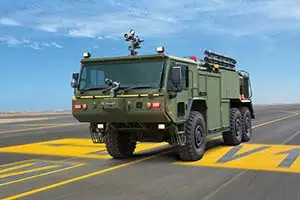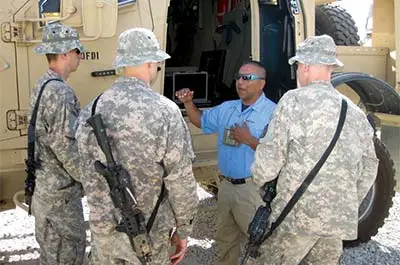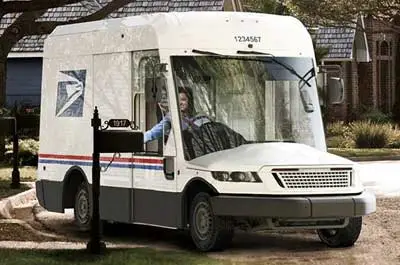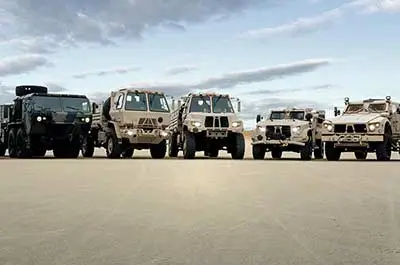OSHKOSH, Wis. (Oct. 4, 2006) – Oshkosh Truck Corporation [NYSE: OSK] announced today the Defense Advanced Research Projects Agency (DARPA) has awarded the company a contract to further develop unmanned ground vehicle technology in preparation for the third DARPA robotic competition, the Urban Challenge. DARPA granted the technology development award based on the merits of an extensive team proposal. The contract is valued up to $1 million.
Oshkosh Truck brings considerable experience to the Urban Challenge, having competed in each of the previous two challenges. In October 2005, the Oshkosh robotic truck, TerraMax, was one of only five entries to complete the course. Team Oshkosh also is uniquely positioned as one of the few teams in the competition that will employ a modified U.S. military vehicle to compete in the simulated urban environment. Oshkosh has partnered with Teledyne Scientific Company, The University of Parma in Italy, Auburn University in Alabama and Ibeo Automobile Sensor GmbH to develop the capabilities required to operate in an urban environment.
“We’re extremely pleased to have been selected by DARPA for this technology development award. Team Oshkosh’s efforts will be focused on enhancing the artificial intelligence and sensing systems of our TerraMax® robotic truck to compete in an urban environment rather than desert terrain,” said Gary Schmiedel, vice president, Advanced Products Engineering, Oshkosh Truck. “Our experiences at the previous Grand Challenge events have given us an excellent understanding of some of the technological challenges we’ll be facing. We’re confident in Team Oshkosh’s ability to field a highly competitive vehicle.”
In an effort to accelerate the development of unmanned technologies capable of merging into moving traffic, negotiating busy intersections and other obstacles associated with urban environments, DARPA is providing this funding to support technology development. To meet the technology development contract terms, Oshkosh Truck must demonstrate satisfactory progress toward pre-established technical criteria during four milestone development tests leading up to the competition.
The November 2007 Urban Challenge will build on the capabilities tested in the first two Grand Challenge events. The 2005 Grand Challenge was the first to produce robotic vehicles with the ability to complete a 132-mile desert course. Similarly, the 2007 Urban Challenge will test the unmanned vehicles’ ability to execute a simulated military mission within the confines of an urban area.
“The U.S. military hopes to make one third of its ground forces autonomous,” said Don Verhoff, executive vice president of engineering and technology for Oshkosh Truck. “Because of the military focus for this challenge and the long-term goals of the sponsoring agency, we have every reason to believe that TerraMax® represents the most realistic model for future defense applications.”
About Oshkosh Truck Corporation
Oshkosh Truck Corporation is a leading designer, manufacturer and marketer of a broad range of specialty commercial, fire and emergency and military trucks and truck bodies. Oshkosh’s products are valued worldwide by fire and emergency units, defense forces, municipal and airport support services, and concrete placement and refuse businesses where high quality, superior performance, rugged reliability and long-term value are paramount.
For more information about Oshkosh Truck Corporation, log onto the company web site at www.oshkoshtruckcorporation.com.
Forward-Looking Statements
This press release contains statements that the Company believes to be “forward-looking statements” within the meaning of the Private Securities Litigation Reform Act of 1995. All statements other than statements of historical fact, including, without limitation, statements regarding the Company’s future financial position, business strategy, targets, projected sales, costs, earnings, capital expenditures, debt levels and cash flows, and plans and objectives of management for future operations, are forward-looking statements. When used in this press release, words such as “may,” “will,” “expect,” “intend,” “estimate,” “anticipate,” “believe,” “should,” “project” or “plan” or the negative thereof or variations thereon or similar terminology are generally intended to identify forward-looking statements. These forward-looking statements are not guarantees of future performance and are subject to risks, uncertainties, assumptions and other factors, some of which are beyond the Company’s control, that could cause actual results to differ materially from those expressed or implied by such forward-looking statements. These factors include the Company’s ability to continue the turnaround of its Geesink Norba Group business, the cyclical nature of the Company’s commercial and fire and emergency markets, risks related to reductions in government expenditures, the uncertainty of government contracts, the availability of defense truck carcasses for remanufacturing, the challenges of identifying acquisition candidates and integrating acquired businesses, risks associated with the implementation of an enterprise resource planning system at McNeilus®; the success of the RevolutionÒ composite concrete mixer drum, the availability of commercial chassis and certain chassis components including engines, and risks associated with international operations and sales, including foreign currency fluctuations. In addition, the Company’s expectations for fiscal 2006 and fiscal 2007 are based in part on certain assumptions made by the Company, including without limitation those relating to the Company’s ability to continue the turnaround of the business of the Geesink Norba Group sufficiently to support its current valuation resulting in no non-cash impairment charge for Geesink Norba Group goodwill; the Company’s ability to sustain flat operating income in the commercial segment and to raise operating income in its fire and emergency segment in fiscal 2007 despite anticipated lower industry demand resulting from changes to diesel engine emissions standards effective January 1, 2007; the Company’s estimates for the level of concrete placement activity, housing starts and mortgage rates; the performance of the U.S. and European economies generally; the Company’s expectations as to timing of receipt of sales orders and payments and execution and funding of defense contracts; the Company’s ability to achieve cost reductions and operating efficiencies, in particular at McNeilus and the Geesink Norba Group; the anticipated level of production and margins associated with the Family of Heavy Tactical Vehicles contract, the Indefinite Demand/Indefinite Quantity truck remanufacturing contract, the MTVR follow-on contract and international defense truck contracts; the expected level of U.S. Department of Defense procurement of replacement parts and services and funding thereof; the Company’s estimates for capital expenditures of municipalities for fire and emergency and refuse products, of airports for aircraft rescue and snow removal products and of large commercial waste haulers generally and with the Company; federal funding levels for U.S. Department of Homeland Security and spending by governmental entities on homeland security apparatus; the availability of chassis components including engines and commercial chassis generally; the Company’s planned spending on product development and bid and proposal activities with respect to defense truck procurement competitions and the outcome of such competitions; the expected level of commercial “package” body and purchased chassis sales compared to “body only” sales; the Company’s ability to integrate acquired businesses and achieve expected synergies; the Company’s ability to close the Iowa Mold Tooling acquisition; the Company’s estimates of the impact of changing fuel prices and credit.
